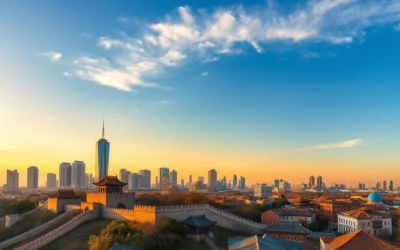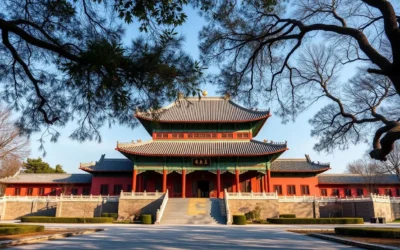✓ Accommodations✓ Flights✓ Rental Cars
Welcome to a journey through the rich linguistic heritage of a fascinating area. This region, home to over 25 million people, boasts a vibrant mix of cultures and traditions. Its strategic location along historic trade routes has shaped its diverse language ecosystem, making it a melting pot of dialects and tongues.
Here, you’ll discover how language connects to the daily lives of its inhabitants. From state-endorsed tongues to minority dialects, each person contributes to this colorful mosaic. The area’s history and geography play a significant role in shaping its linguistic landscape.
Whether you’re curious about the dominant tongues or the lesser-known dialects, this exploration will give you a deeper understanding of how language defines this unique part of the world. Let’s dive in and uncover the stories behind the words.
Language Landscape of Gansu Province
Explore the unique blend of tongues that shape daily life in this culturally rich region. Here, you’ll find a fascinating mix of state-supported languages and minority dialects, each adding to the area’s vibrant identity. The linguistic diversity reflects both historical influences and modern policies.

Official Languages and State Support
Mandarin Chinese, also known as Putonghua, is the most widely spoken language, used by approximately 70% of the population. It’s supported by state policies aimed at promoting unity and communication across the region. Tibetan and Mongolian are also recognized, with significant speaker bases in specific areas.
Government initiatives ensure these languages are taught in schools and used in official settings. This approach balances national cohesion with respect for local traditions. For example, over 1,000 schools offer bilingual education programs, particularly for minority languages.
Minority Languages and Regional Dialects
Beyond the official languages, you’ll encounter a variety of minority tongues. Tibetan is spoken by around 15% of the population, primarily in the southern regions. The Salar language, used by about 2%, is another example of the area’s linguistic richness.
Dialects like the Lanzhou sub-dialect play a key role in everyday communication. Influences from neighboring Inner Mongolia add another layer to the region’s linguistic tapestry. These dialects and languages are not just tools for communication—they’re vital parts of cultural identity.
Despite the dominance of Mandarin, many residents are bilingual, speaking both the official language and their native dialect. This bilingualism highlights the region’s ability to balance tradition with modernity.
Historical Evolution of Gansu’s Languages
Step into the past and uncover how languages in this region have transformed over centuries. The linguistic landscape here is a testament to the interplay of trade, culture, and policy. From ancient dynasties to modern reforms, each era has left its mark on the way people communicate.
Timeline of Language Policy Developments
The history of language policies in this area is deeply rooted in its dynastic past. During the Tang dynasty, the Silk Road brought merchants and scholars, fostering a multilingual environment. This exchange laid the foundation for linguistic diversity.
In the 20th century, the government introduced policies to promote Mandarin as the national language. This shift aimed to unify the country while respecting local dialects. Today, bilingual education programs ensure that both official and minority languages thrive.
Influence of the Silk Road and Trade Routes
The Silk Road was more than a trade route—it was a bridge for cultural and linguistic exchange. Merchants, travelers, and scholars from across Asia and Europe brought their languages, enriching the region’s linguistic tapestry.
This influence is still evident today. For example, Tibetan and Mongolian languages retain their prominence in certain areas, reflecting centuries of cultural interaction.
“The Silk Road was not just a path for goods; it was a highway for ideas, languages, and cultures.”
| Period | Key Developments |
|---|---|
| Tang Dynasty | Silk Road trade fosters multilingualism. |
| 20th Century | Mandarin promoted as the national language. |
| Present Day | Bilingual education supports linguistic diversity. |
As you explore this region’s linguistic history, you’ll see how time and culture have shaped its unique identity. From ancient trade routes to modern policies, every chapter of history has contributed to the rich tapestry of languages spoken here today.
Gansu Province, China: Official and widely spoken languages
Discover how state-led efforts shape the linguistic diversity of this culturally rich area. The government plays a key role in fostering unity while respecting the unique needs of minority communities. Through policies and education, both majority and minority languages thrive, creating a balanced linguistic landscape.

Standardized Scripts and Unity
Standardized scripts are a cornerstone of these initiatives. They ensure clear communication across the region, bridging gaps between different linguistic groups. For example, Mandarin uses Simplified Chinese characters, while Tibetan employs its own unique script.
These scripts are taught in schools, helping students master both their native and official languages. This approach promotes linguistic unity while preserving cultural heritage.
Historical Influences on Modern Policies
Modern language policies are deeply rooted in history. The influence of ancient dynasties can still be seen in key cities like Lanzhou. During the Tang dynasty, the Silk Road brought diverse languages, shaping the area’s linguistic identity.
Today, these historical influences inform policies that protect minority languages. For instance, bilingual education programs ensure that both Mandarin and local dialects are taught in schools.
“Language is not just a tool for communication; it’s a bridge that connects cultures and histories.”
| Initiative | Impact |
|---|---|
| Standardized Scripts | Promote linguistic unity across the region. |
| Bilingual Education | Protects minority languages while ensuring educational progress. |
| Historical Policies | Shaped by ancient dynasties, these policies continue to influence modern practices. |
These initiatives highlight the state’s commitment to preserving linguistic diversity. By balancing tradition with modernity, they ensure that every community’s voice is heard.
Linguistic Glossary: Key Terms and Dialects
Understanding the language of a region opens doors to its culture and history. In this section, you’ll find a clear glossary of essential terms and an explanation of regional dialects. Whether you’re exploring urban areas or rural towns, this guide will help you navigate the linguistic diversity.

Glossary of Language Terminology
Script: A system of written characters used to represent language. For example, Mandarin uses Simplified Chinese characters, while Tibetan employs its own unique script.
Dialect: A regional variety of a language, often with distinct pronunciation and vocabulary. The Lanzhou sub-dialect is a key example in urban areas.
Language Policy: Government rules that promote or regulate language use. These policies ensure both unity and respect for minority languages.
Regional Dialects Explained
Dialects vary widely between urban and rural areas. In the capital, Mandarin dominates, while smaller towns often preserve older dialects. Mountain regions, like those in the south, are home to unique linguistic traditions.
For instance, the Lanzhou sub-dialect is common in urban centers, while rural areas might use more traditional forms of speech. These differences reflect the region’s rich cultural tapestry.
| Region | Dialect | Characteristics |
|---|---|---|
| Urban (Capital) | Lanzhou Sub-Dialect | Modern pronunciation, influenced by Mandarin. |
| Rural (Town) | Traditional Dialects | Older forms of speech, less influenced by modern changes. |
| Mountain Areas | Unique Dialects | Distinct vocabulary and pronunciation, preserved over time. |
By exploring these terms and dialects, you’ll gain a deeper appreciation for the region’s linguistic heritage. For more on the varieties of Chinese, visit this resource.
Modern Language Use and Education in Gansu
Language education in this region blends tradition with global influences, shaping the future of its students. Schools and universities here are at the forefront of this dynamic, integrating both local dialects and international languages into their curricula. This approach ensures that students are well-prepared for a globalized world while preserving their cultural roots.

Language in Schools and Higher Education
In schools, Mandarin remains the primary language of instruction, ensuring students master this widely spoken tongue. However, bilingual programs are also common, particularly in areas near the Yellow River. These programs teach both Mandarin and minority languages, fostering a sense of unity and respect for diversity.
Higher education institutions emphasize English as a required course, reflecting its global importance. Many students near urban centers are exposed to English media, which enhances their proficiency and opens doors to international opportunities.
Impact of Global English and Media Influence
Global English has become a key part of education, especially in larger cities. Students here often consume English media, from movies to online content, which complements their classroom learning. This exposure helps them develop practical language skills that are valuable in today’s interconnected world.
In the Yellow River region, traditional practices coexist with these global influences. Han Chinese communities, for example, maintain their linguistic heritage while embracing the benefits of English education. This balance ensures that students are both globally competitive and culturally grounded.
“Language is the bridge between tradition and modernity, connecting students to their roots and the world.”
For more insights into the linguistic diversity of this region, explore this resource.
Conclusion
Exploring the linguistic diversity of this region reveals a fascinating blend of official and minority tongues. From the north to the south, the difference in dialects reflects the area’s rich cultural heritage. Historical trade routes and key rivers have shaped this unique community, making it a crossroads of languages.
Urban centers often favor dominant languages, while rural areas preserve older dialects. This difference highlights the balance between tradition and modernity. Accurate information is essential to understanding these linguistic nuances.
Located near significant borders and rivers, this area’s strategic position has influenced its language landscape. Whether you’re studying its history or its present, the region’s linguistic richness offers endless insights. Dive deeper into this topic with resources like this detailed analysis.
Appreciate the unique community and cultural heritage that make this region so special. Its languages are not just tools for communication—they’re a bridge to its past and future.
The above is subject to change.
Check back often to TRAVEL.COM for the latest travel tips and deals.






